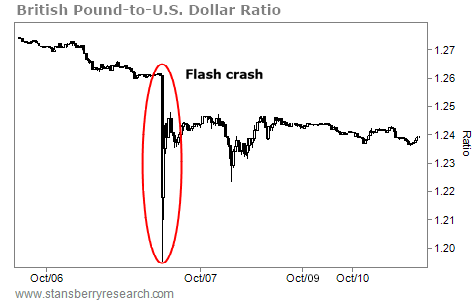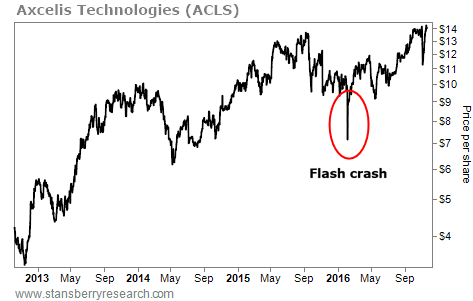| Home | About Us | Resources | Archive | Free Reports | Market Window |
|
Editor's note: Our offices are closed tomorrow for Thanksgiving. Look for the next edition of DailyWealth on Friday. Enjoy the holiday.
Two Strategies to Avoid a 'Flash Crash' and Sleep Well at NightBy
Wednesday, November 23, 2016
Last month, I awoke to the following dramatic headline:
It was a good reminder of how important it is to tune out the day-to-day noise of the markets. But it also served as another valuable lesson for investors. Let me explain...
Entering a stop loss with your broker is one of the most dangerous things you can do as an investor.
When you enter a stop, your broker places it in the market. At that point, market makers – the people who match buyers with sellers – can tell exactly where you're willing to sell.
That means market makers can temporarily drop the price and pick off your stop – even if the price immediately rebounds.
Think of it like playing poker with your hand showing. It tells other market participants exactly when you'll "fold." If you don't enter stops in the market, that can't happen.
Plus, intraday prices are much more volatile than closing prices. If you enter your stops in the market, you open yourself up to stopping out on a "flash crash" type of move, just like we saw with the pound in the newspaper headline above.
Here's what the chart of the British pound looked like before, during, and after its intraday plunge...
 The "volatility quotient" on the pound is about 7%. In layman's terms, that means it's reasonable to expect the pound to move up or down in a range of about 7% over the course of a year or more. Instead, investors saw a 6% correction in the pound in a matter of minutes. And that isn't the only time a "flash crash" has happened. On May 6, 2010, nearly $1 trillion of market capitalization disappeared from the market and reappeared in the span of just 30 minutes.
Big blue-chip companies crashed for a few minutes. Cigarette giant Philip Morris (PM) fell 9%... iPhone maker Apple (AAPL) fell 22%... and consumer-products behemoth Procter & Gamble (PG) fell an incredible 36%. All three recovered most of their losses by the end of the trading day.
Such "unexplained" events happen in the markets far too often these days.
Earlier this year, semiconductor company Axcelis Technologies (ACLS) opened at $9.64 per share before suddenly dropping 26% to a low of $7.16. It closed the day at $9.36... down less than 3%. You can see the spike lower in the chart below...
 If you had entered a stop loss with your broker, you would have stopped out and missed out on huge gains. The stock recovered almost all of its gains later that day and marched straight higher to $14 a share in the months to come. That's why my TradeStops software always uses end-of-day closing prices for stop losses. That way, a "flash crash" or a knee-jerk reaction to an earnings announcement won't necessarily kick you out of a winning trade.
Keep your stops out of the market and use end-of-day closing prices as the basis for evaluating your stops. Using these two strategies will help you sleep a lot better at night knowing that the market makers can't pick you off.
Regards,
Dr. Richard Smith
Further Reading:
Read more of Richard's tips on managing risk here...
Over the past seven years, Mark's account is up more than $181,000. The problem is, he's leaving thousands of dollars on the table with his trades...
"In nearly 20 years of firsthand market experience and a dozen years of helping tens of thousands of individual investors, I've learned there is one thing that threatens our investment success more than anything."
Market NotesTHIS INVESTMENT CONSISTENTLY BEATS THE MARKET Today's chart shows an easy "one click" way to outperform the S&P 500...
Over the years, few investors have consistently beaten the broad stock market. Finding an investment manager who can do it regularly is like finding a needle in a haystack. But one of the world's most famous investors has done just that...
We're talking, of course, about the Oracle of Omaha, Warren Buffett. Buffett's holding company, Berkshire Hathaway (BRK-B), is up more than 120% over the last 10 years – far outperforming the S&P 500, which is up less than 60%. Buffett's method of buying high-quality businesses at good prices has helped him produce one of the best investing track records in history.
As you can see from the chart below, business has been good for the legendary investor. Berkshire shares are up more than 27% from their January lows... and are trading at a new all-time high. If you're wondering why Buffett has a reputation for being one of the all-time greats, this is why...
_NX0Z8VIRDJ.png) |
Recent Articles
|



